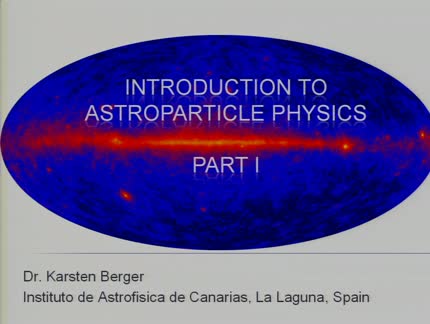Found 16 talks width keyword gamma rays

Abstract
Relativistic jets in AGN in general, and in blazars in particular, are the most energetic and among the most powerful astrophysical objects known so far. Their relativistic nature provides them the ability to emit profusely in all spectral ranges from radio wavelengths to gamma-rays, as well as abrupt variability in all time scales (from hours to years). Since the birth of gamma-ray astronomy, locating the origin of gamma-ray emission has been a fundamental problem for the knowledge of the emission processes involved. Deep and densely time sampled monitoring programs with the Fermi Gamma-ray Space Telescope and several other facilities at most of the available spectral ranges (including polarization measurements where possible) are starting to shed light for the case of blazars. After a short review of the status of the problem, some of the latest results locating the GeV emission in the jets of some blazars, at >10 parsec from the central AGN engine, will be presented together with their implications about the gamma-ray emission mechanisms involved

Abstract
The MAGIC telescopes discovered very high energy (VHE, E>100 GeV) gamma-ray emission coming from the distant Flat Spectrum Radio Quasar (FSRQ) PKS 1222+21 (4C +21.35, z=0.432). It is the second most distant VHE gamma-ray source, with well measured redshift, detected until now. The detection coincides with high energy MeV/GeV gamma-ray activity measured by the Large Area Telescope (LAT) on board the Fermi satellite. The VHE and MeV/GeV spectra, corrected for the absorption by the extragalactic background light, can be described by a single power law with photon index 2.72 ± 0.34 between 3 GeV and 400 GeV, consistent with gamma-ray emission belonging to a single component in the jet. The absence of a spectral cutoff constrains the gamma-ray emission region to lie outside the Broad Line Region, which would otherwise absorb the VHE gamma-rays. On the other hand, the MAGIC measurement of a doubling time of about 9 minutes indicates an extremely compact emission region, in conflict with the "far dissipation" scenario. This result challenges jet emission models in FSRQs and indicates the importance of jet sub-structures.

Abstract
The extragalactic background light (EBL) is of fundamental importance both for understanding the entire process of galaxy evolution and for gamma-ray astronomy, but the overall spectrum of the EBL between 0.1 and 1000 microns has never been determined directly from galaxy spectral energy distribution (SED) observations over a wide redshift range. Galaxy SED-type fractions from z=0.2-1 are estimated from a multi-wavelength sample from the AEGIS collaboration that allows a new determination of the evolving EBL. Then, the transparency of the Universe to very high energy (VHE) gamma-ray photons is derived. We find the maximum transparency of the Universe allowed by the standard framework. This result challenges current VHE observations of high redshift blazars. A solution to this problem is discussed utilizing VHE spectra of the highest redshift blazars assuming the existence of a plausible dark matter candidate known as axion-like particle.

Abstract
3C 279, the first quasar discovered to emit VHE gamma-rays by the MAGIC telescope in 2006, was re-observed by MAGIC in January 2007 during a major optical flare and from December 2008 to April 2009 following an alert from the Fermi space telescope on an exceptionally high gamma -ray state. The January 2007 observations resulted in a detection on January 16 with significance 5.2 sigma, corresponding to a F(> 150 GeV)(3.8±0.8) 10^-11 ph cm-2 s-1 while the overall data sample does not show significant signal. The December 2008 - April 2009 observations did not detect the source. We study the multi-wavelength behaviour of the source at the epochs of MAGIC observations, collecting quasi-simultaneous data at optical and X-ray frequencies and for 2009 also gamma-ray data from Fermi. We study the light curves and spectral energy distribution of the source. The spectral energy distributions of three observing epochs (including the February 2006, which has been previously published in Albert et al. 2008a) are modelled with one-zone inverse Compton models and the emission on January 16, 2007 also with two zone model and with a lepto-hadronic model. We find that the VHE gamma-ray emission detected in 2006 and 2007 challenges standard one-zone model, based on relativistic electrons in a jet scattering broad line region photons, while the other studied models fit the observed spectral energy distribution more satisfactorily.

Abstract
This seminar talk will give a short overview of the current status of the field of Astroparticle Physics. The subject includes a great variety of instruments working in different energy ranges (from a few MeV to 1020 eV) and studying different particles (neutrinos, protons, gamma-rays and more). Finally, a short discussion regarding the connection between the observations and the physics at the Large Hadron Collider will be discussed.
Abstract
This seminar talk will give a short overview of the current status of the field of Astroparticle Physics. The subject includes a great variety of instruments working in different energy ranges (from a few MeV to 1020 eV) and studying different particles (neutrinos, protons, gamma-rays and more). Finally, a short discussion regarding the connection between the observations and the physics at the Large Hadron Collider will be discussed.<< First « Newer 1 | 2 Older »
Upcoming talks
- Classical Be stars - Constraining binary interaction physics in massive starsDr. Julia BodensteinerThursday April 25, 2024 - 10:30 GMT+1 (Aula)
- Runaway O and Be stars found using Gaia DR3, new stellar bow shocks and search for binariesMar Carretero CastrilloTuesday April 30, 2024 - 12:30 GMT+1 (Aula)









